Have you ever wondered if it is possible to build a simple amplifier of high sound fidelity? Have you thought if audiophiles are right claiming that quality must cost a fortune? If so, I suggest to build a simple A-class, single-ended amplifier and hear it with your own ears. It has a simple output stage and highest sound quality, free from a crossover and other harmonic distortions.
MOSFET transistors make the output sound valve-like. It resembles the sound of my grandpa’s old radio, on which he listened to the Free Europe broadcasts more than twenty years ago. The saturation characteristics of MOSFET transistors are similar to those of thermionic valves.
The main drawback of such a design is it’s low efficiency, of the order of several percent, but headphones require only some tens miliwatts of power, so we can afford several watts of energy to be radiated as heat.
The circuit is presented on the picture below:
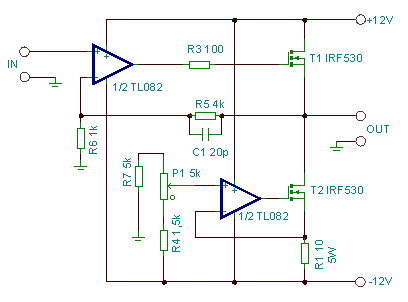
This is classics. And there are commited some audiophile’s “deadly sins”.
First: op-amp in the input stage. It is said, that it causes a lot of distortions, harsh sound and some other problems, but I decided to risk, knowing, that it is the output stage, that controls the harshness / softness of sound. The catalog data of this amplifier say that nonlinear harmonic distortion coefficient of this chip is of the order of 0.003%. Very low.
Second: global feedback loop (resistors R5, R6). It was necessary, because the amplifier was to relay the frequencies as low, as possible, so I had to give up on an output capacitor. Such a capacitor cuts the constant bias output component (very dangerous for the headphones), but also acts as a high bandpass filter and impairs the bass performance. So, capacitors in the signal path destroy the sound quality more than the global feedback loop, which also prevents the constant voltage on the headphones.
The amplifier is powered by symmetric stabilized voltages.
The source load is a classical current source, also made with a MOSFET transistor and an opamp. The idle current of the amplifier is set with the potentiometer P1 while measuring voltage across the resistor R1. For 22 Ohm headphones the current of 185 mA is sufficient. The more current, the amplifier is more resistant to overdrive, but dissipates more heat. The above value of the idle current is fully sufficient for human loudness tolerance.
The amplification coefficient is set by R5 and R6 values by equation: amplification=1+R5/R6. In our example it has the value of 5. It should be chosen dependent on what will be the source of signal for our amplifier.
The capacitor C1 is supposed to prevent the amplifier from high frequency self-oscillations, but it has emerged, that with this capacitor the circuit oscillated at about 2 MHz, after I got rid of this capacitor, the amplifier does not make any trouble.
The MOSFET transistors should be placed on decent radiators because they dissipate lot of heat (several watts). Transistors should be electrically insulated from radiators with mica or silicone washers.
The amplifier consumes about 500 mA on each power branch (+12 and -12 V) and the power source should be able to deliver such a current. Usually the standard application of LM7812 and LM7912 is sufficient, powered by a 2 x 12 V 20-40 W transformer, rectifier bridge and filter capacitors. The voltage regulators also should be heat-sinked and insulated from radiators, similarly as MOSFETs.
Resistor R3 should be placed as close to the transistor as possible.
The circuit was made out of pure curiosity, but the sound showed so high quality and real valve-like “softness”, that it was mounted in an aluminum casing and serves as a part of the electroacoustic set.
Below we present some oscillograms depicting the amplifier fidelity. The upper graph is the input signal from a generator, the lower one – output signal.
20 kHz, square-wave, gain 2x:
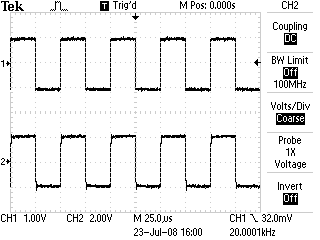
100 kHz, square-wave, gain 2x:
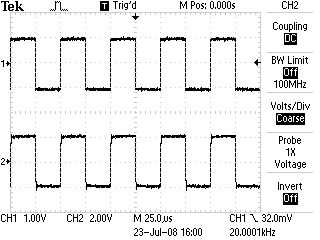
500 kHz, sine-wave, gain 2x:
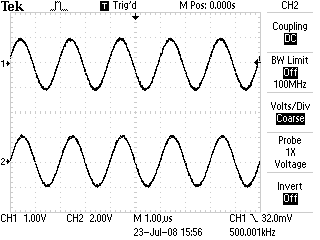
1 Hz, sine-wave, gain 2x:
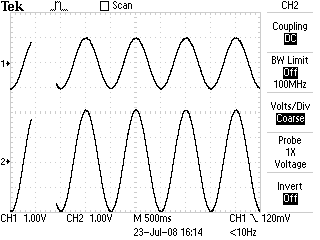
The useful bandwidth reaches above 500 kHz, the square-wave input signal does not cause any ringing, the sound is soft, “valve-like”. As for so simple construction the amplifier is excellent.
Piotr Struski, October 22-nd 2008
